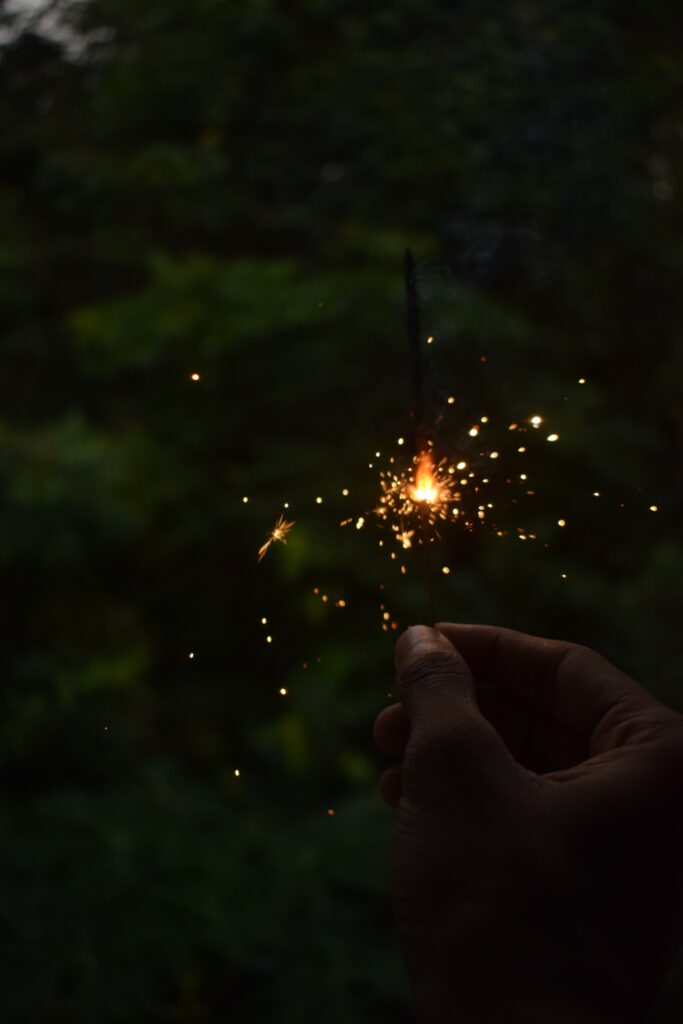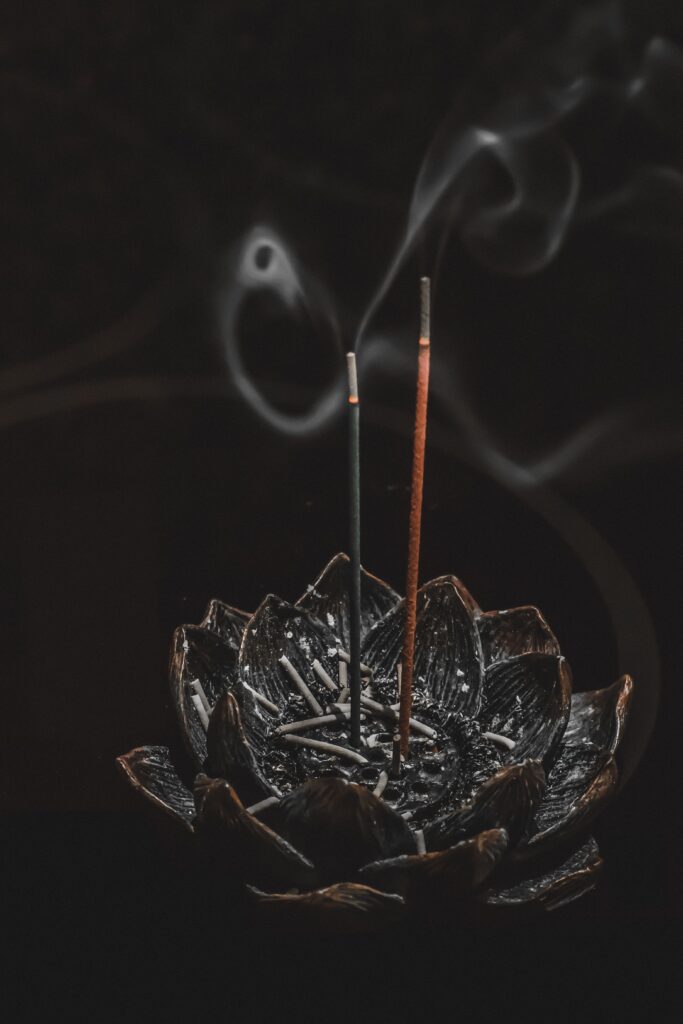 As we pass the threshold of the Midsummer, the revered day that embodies the essence of sacred fire, the day of longest light, we come to deeply witness the intertwining elements of fire and air. In the throws of the late summer, we are experiencing the true peak of the heat. The Sun remains high in the sky, and though often accompanied by the power of a brief afternoon thunderstorm, these months often allow the boldness of the solar flame to rule unbound. We no longer observe the nourishing rain of the spring, and we witness the plants quickly beginning to bear fruit, for the whispers of the harvest season and the anticipation of fall slowly begin to arrive. And with this whisper, we start to feel the presence of the seasonal transition. The time in which we acknowledge that the night starts to ever so slowly creep into the day, and the flame of the summer heat, while still proud and prominent, so very slowly starts to snuff. This is the period of the smoldering coals of the season.
As we pass the threshold of the Midsummer, the revered day that embodies the essence of sacred fire, the day of longest light, we come to deeply witness the intertwining elements of fire and air. In the throws of the late summer, we are experiencing the true peak of the heat. The Sun remains high in the sky, and though often accompanied by the power of a brief afternoon thunderstorm, these months often allow the boldness of the solar flame to rule unbound. We no longer observe the nourishing rain of the spring, and we witness the plants quickly beginning to bear fruit, for the whispers of the harvest season and the anticipation of fall slowly begin to arrive. And with this whisper, we start to feel the presence of the seasonal transition. The time in which we acknowledge that the night starts to ever so slowly creep into the day, and the flame of the summer heat, while still proud and prominent, so very slowly starts to snuff. This is the period of the smoldering coals of the season.
 Photo by Alonso Reyes on Unsplash[/caption] The elements are the bones of our natural world - that from which everything is made, a beautiful dance and song made up of how they interact with each other. The way in which they interface can bring both balance and imbalance, harmony and disorder. Air is necessary to invoke the flame, but also has the power to suffocate it. All that is of the natural world embodies the elements, and this is so evident in the plants. They are embraced in the appearance of the plants, the way they harmonize with the ecosystem of which they are a part, and ultimately in their energetic and medicinal properties. Plants create alchemy out of the elements to support healing and vitality. Come dance with us in this two-part series where we explore and find curiosity in the elements, how they support our herbal journey, and the way they manifest in the plant allies.
Photo by Alonso Reyes on Unsplash[/caption] The elements are the bones of our natural world - that from which everything is made, a beautiful dance and song made up of how they interact with each other. The way in which they interface can bring both balance and imbalance, harmony and disorder. Air is necessary to invoke the flame, but also has the power to suffocate it. All that is of the natural world embodies the elements, and this is so evident in the plants. They are embraced in the appearance of the plants, the way they harmonize with the ecosystem of which they are a part, and ultimately in their energetic and medicinal properties. Plants create alchemy out of the elements to support healing and vitality. Come dance with us in this two-part series where we explore and find curiosity in the elements, how they support our herbal journey, and the way they manifest in the plant allies.
On the Energetics of Fire
The energy of fire is associated with cleansing, transformation, renewal. It is symbolized by the phoenix who rises from the ashes, having been created anew despite destruction. Fire corresponds to the sacred transition. It invokes power and passion. In our bodies fire corresponds with our inner strength, our motivations and our energy. When our inner fire burns bright, we may feel unstoppable, and we may not experience such things as stagnation, or weakness in our voice. Fire corresponds to our digestion, and how we are fueled by nourishment. Fire has an affinity for the Sun, and is manifests in the power of solar energy. It often corresponds with the bright and bold colors of red, yellow, orange, and even deep vibrant blues and whites.
 Photo by Alonso Reyes on Unsplash[/caption] When out of balance, fire can be synonymous with devastation. It has the power to be all consuming - we witness this energy within our drying landscapes, or scorched soils parched by drought. Fire without intention and control becomes wild, destructive. This arises in our bodies and emotions in the form of unbridled anger or rage, or in the way we may harshly become our own critic. It arises when we do not take time for rest, burning our internal candle at both ends. Understanding the energetics of fire can help us to align with this energy when we are in need, and to help co-create with the energy of the other elements when we seek balance.
Photo by Alonso Reyes on Unsplash[/caption] When out of balance, fire can be synonymous with devastation. It has the power to be all consuming - we witness this energy within our drying landscapes, or scorched soils parched by drought. Fire without intention and control becomes wild, destructive. This arises in our bodies and emotions in the form of unbridled anger or rage, or in the way we may harshly become our own critic. It arises when we do not take time for rest, burning our internal candle at both ends. Understanding the energetics of fire can help us to align with this energy when we are in need, and to help co-create with the energy of the other elements when we seek balance.
Herbal Allies of Fire
The season that aligns with the energy of fire, is unsurprisingly summer. This is the time in the turning of the year that the sun is most empowered and energy in all forms is at its peak. It is the time in which we retreat to the lakes to cool off, and the fireflies dance in the night as if to honor the solar energy. Many of the herbs that have an affinity for fire also are prevalent at this time of the year, meeting their growth apex along with Midsummer. Their faces often follow the sun as it passes through the sky, and they tend to have colors that resemble a burning flame. Many of these allies include:- St. John’s Wort: This herb is known to bloom at the same time as the summer solstice, its bright yellow flowers resembling small little burning campfires. The flowers when crushed also release a deep red substance known as hypericin, which is responsible for the rich, vibrant color St. John’s Wort oil is known for. This herb is an ally for helping us stoke our inner fire, when we may feel worn down or need our spirit activated. Many herbs that have an affinity for the sun also have properties that help protect against damage caused by the sun through burns, and St. John’s Wort is an incredible support for this purpose. This herb, when planted, also embodies fire in that it has the ability to spread at the rate of a wildfire, and can be quite invasive, so plant with care.
- Sunflower: Aptly named for not only the appearance of this flower which very much corresponds to the solar shape of the petals, but also because this flower gives such deep reverence to the sun. Sunflowers are known for their heliotropism, or the way that they track the sun as it passes through the sky, beginning with the early morning dawn and concluding with the dusk as it once again passes below the horizon. Other than their seeds, which are a healthy source of fat and protein, a beautiful way to co-create with the fire energy of sunflowers is through a flower essence. Flower essences are the beautiful alchemy of fire and water dancing together, as the sun charges and activates the energies of the water that interacts with the flower. Sunflower flower essences help to remind us of our own light, and how it shines brightly in the gloom. It helps you recognize your radiant form of self, and to celebrate your own individuality and uniqueness.
- Fireweed: This gorgeous high-alpine wildflower is named for the fact that it looks like a deep fuschia sparkler firework. Something unique about this flower is that it acts as a sort of countdown to summer, dropping flowers and growing smaller as the season wanes. This beautiful flower is also an ode to the beauty that follows destruction after a wildfire, for it blooms in areas that have burned, helping to restore the plant ecosystem and serving as a strong foundation for regrowth. Medicinally, fireweed can be an ally for boosting our digestive fire, helping move through stagnation, and providing nourishment for the bacteria in our gut.
 Photo by Aswin Raj on Unsplash[/caption]
Photo by Aswin Raj on Unsplash[/caption]
On the Energetics of Air
The energies of air correspond with movement, clarity, evolution, and change. It is that power that cannot be seen but yet can be felt when the wind whips our hair, or calls in the thunderstorm. In our bodies, air is sacred breath, it is vitality and life force. When in balance, we feel calm, grounded, and regulated. The energy of air can be witnessed in the movement of the wind. It can be soft and subtle, a gentle tickling breeze, or a violent, ripping wind that is infused with chaos and can be quite destructive. When out of balance in our body, we may experience dryness, and our spirit may feel aloof, adrift, and without a tether to keep us rooted.
 Photo by Marc Kleen on Unsplash[/caption] Air is never a constant, always shifting and moving, and can be an ally for when we may feel stuck. It can help remind us that change is not only inevitable, but often necessary, for without change we cannot evolve. May we find surrender in allowing the wind to carry us like a grain of sand across the desert, invoking our curiosity and wonder at the adventure that is life.
Photo by Marc Kleen on Unsplash[/caption] Air is never a constant, always shifting and moving, and can be an ally for when we may feel stuck. It can help remind us that change is not only inevitable, but often necessary, for without change we cannot evolve. May we find surrender in allowing the wind to carry us like a grain of sand across the desert, invoking our curiosity and wonder at the adventure that is life.
Herbal Allies of Air
The season that aligns with the energy of air is spring. It is a time of intense growth, re-emergence, and the time of a deep, collective inhale that comes with the first breath of birth. It is embodied by the way a seedling emerges from the darkness below the soil, reaching tall for the clouds and the sky above. Herbs that have an affinity for air can be identified by the way this element manifests in their form. They often tend to be tall and thin, their leaves sparse and open to allow the movement of air through them. They also often tend to be hollow in their stem, as if serving as a temple to this element within their being. Many of these herbs also are aromatic, bringing a sweet aroma and scent into our being as we share breath with them. Herbs of air include:- Sacred Smoke Herbs: These herbs are aromatic herbs that hold deep reverence and wisdom, and are often used in ritual or intentional cleansing. Alchemizing with our intentions, they have the ability to raise or expel energy. They also interact with our nervous system, helping draw us into a state of sacred space, deeply grounding us, and helping us to pass through the threshold into the mystical.
- Sacred smoke herbs include Lavender, Mugwort, Juniper, Sage, Vervain, and Rosemary, among many others. Herbs also included in this category are herbs that are deeply sacred to Indigenous communities who have long tended to them with profound care and stewardship, but have become endangered, commodified, and overharvested including White Sage and Palo Santo. Magic can happen when we reconnect to the herbs that were used within our own lineage and ancestry, but if either of these herbs call to you, please use deep care these herbs should only be sourced ethically and sustainably (or grown yourself in your garden!) and with respect to Indigenous communities.
 Photo by David Brooke Martin on Unsplash[/caption]
Photo by David Brooke Martin on Unsplash[/caption]
- Yarrow: This gorgeous and abundant herb that resembles a cloud is incredibly multi-functional. Its thin stem and wispy leaves are an ode to the element of air, and can help provide relief for our lungs when we are experiencing a dry, scratching cough that seems to persist. Deeply aromatic, this herb can also be used in incense and sacred smoke. Yarrow can also bring relief to skin that is irritated or inflamed, particularly due to dryness.
- Mullein: This herb has an affinity for our respiratory system and is a profound ally for the breath. While a larger plant, this herb still embodies many of the characteristics commonly found in air-element plants. It is tall, with a thin stem, and its leaves are broad. This herb, which is abundant (and can be invasive in some environments), is an incredible ally for lung support when the air is full of pollutants and particulate matter, much like what we see in an area impacted by a large wildfire. This herb has properties that are soothing and cleansing to the lungs, including being an expectorant, helping us to dislodge materials that are disruptive to our breathing such as mucus. Mullein also serves as a beautiful base for an herbal smoking blend, which is another way to work with herbs corresponding with air. An alternative to tobacco, herbal smoking blends can have benefits including calming or energizing effects when inhaled.



